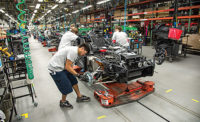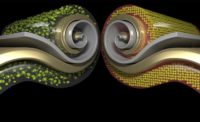Hella GmbH & Co. has been synonymous with automotive lighting for decades. But, the 124-year-old company produces more than just top-of-the-line headlamps. In addition to front, rear and interior lighting, Hella makes accelerator pedals, brake pedals, battery management systems, thermal management systems and other innovative devices that are used by numerous automakers. Its products can also be found in a variety of other vehicles, including buses, trucks, tractors and construction equipment.
The Tier One supplier, which along with Faurecia is part of the recently formed Forvia Group, operates factories around the world, including its flagship plant in Lippstadt, Germany. It also operates a state-of-the-art facility in Flora, IL, that assembles a variety of products, such as actuators, body electronics, sensors and other advanced driver assistance system (ADAS) components.
One of Hella’s newest products is a single front panel that has been designed specifically for electric vehicle applications. It integrates ADAS components, such as cameras, lidar, radar and radomes, with headlamps into one subassembly that helps automakers consolidate parts.
Last year, Hella unveiled a comprehensive lighting package for the Enyaq iV, a battery-powered SUV produced by Skoda Auto, a European brand owned by Volkswagen AG. The main feature is the dynamic illumination of the radiator grille. The “crystal face" gives the EV a distinctive appearance.The illuminated radiator grille is realized by 131 individual LEDs that couple into a thick-walled EdgeLight light guide and illuminate the 18 vertical ribs and a horizontal band of the grille. Together with the surface texture of the ribs, this creates the crystal effect characteristic of the radiator grille.
While driving, the dynamic grille lighting supports the functionalities of the main headlamp and illuminates the road area. It also implements coming-home and leaving-home animations.
Autonomous and Electric Mobility recently asked Joerg Weisgerber, managing director of electronics at Hella, what other types of new products his company is developing for e-mobility applications.
AEM: How has Hella been making the transition from vehicle lighting technology to advanced driver assistance systems?
WEISGERBER: It’s not something that we just started. We’ve actually been a supplier of radar technology for more than 20 years. We also provide control electronics and software. Recently, we enhanced our product features by switching over from 24 to 77 gigahertz technology, which provides more resolution and range.
AEM: How are headlights becoming smarter and adapting to new roles in electric and autonomous vehicles?
WEISGERBER: The technology has changed from a normal lightbulb and a little bit of plastic into LED arrays that feature smart electronics. That enables us to provide adaptive and adjustable light beams. The typical headlight today is comprised of hundreds of LEDs that offer more features and functions than ever.
AEM: Can you provide more details about your front-end panel technology? How can this help automakers develop EVs and AVs?
WEISGERBER: Front panels have two advantages. One is a distinctive design element, especially for nighttime driving. The other is to provide different light patterns and colors that can even project information onto the front of a car. For instance, that feature could be used to alert pedestrians and other motorists that a vehicle is driving in autonomous mode.
AEM: Can you talk about Hella’s battery management systems (BMS) for electric vehicles?
WEISGERBER: The heart of an electric car is its battery and motor. It’s important to manage power consumption and charging. We have produced more than 30 million intelligent battery sensors since 2000. The BMS monitors the health of the battery and ensures optimum performance. We offer an onboard, high-voltage charger that can be integrated into vehicles with less package space without compromising on performance.
AEM: Can you provide more details about Hella’s thermal management systems for EVs?
WEISGERBER: If a lithium-ion battery gets too warm or too cold, it loses its power. We developed a thermal management system specifically for the temperature requirement of EVs. We combine a variety of actuators, pumps and sensors into a complete cooling system. This approach is our Coolant Control Hub. It brings what used to be a decentralized system into a centralized system with many efficiencies.
AEM: How is the transition from internal combustion engine vehicles to electric vehicles affecting plant floor operations in your factories?
WEISGERBER: There are some higher voltage requirements for end-of-line testing. But, in general, there is not much change from ICE to EV product assembly. We still perform in-circuit and continuity testing. The move to e-mobility is not really changing the basic way that we set up and operate our assembly lines. We typically build new lines for most of the new products that we develop.
AEM: Have you invested in any Industry 4.0 technology to prepare your factories for the EV era?
WEISGERBER: We have focused a lot on applications of data analytics and artificial intelligence. For instance, we have developed some in-house technology that uses AI to check for welding quality. We also have a venture office in Silicon Valley where we reach out to start-up companies that are developing advanced manufacturing technology. In addition, we encourage our suppliers to deploy new tools and technologies.
AEM: How is Hella preparing for the future era of autonomous vehicles?
WEISGERBER: Most of our focus has been on product design, such as developing functions and features that can be combined with other sensor technology to enhance the performance of autonomous vehicles. It’s more of an evolutionary step on top of the ADAS features that we have already developed. We recently developed a new brake pedal for use with X-by-wire technology that eliminates a lot of traditional mechanical components.
AEM: Can you provide more details about the brake-by-wire pedal?
WEISGERBER: The brake-by-wire pedal simulates the feel and behavior of a conventional brake system, where the pedal is mechanically connected to the braking system via a rod. Because the control of the brake commands in our by-wire system is only performed fully electrically, the functions of automated driving are also simultaneously supported. In addition, the customized setting of the brake function is made possible, which means that the brake force can be specifically adapted to suit every driving scenario. Furthermore, since only lightweight plastics are used for the fully electric brake-by-wire pedal, the component weight is reduced by up to 20 percent. This can help increase the range of electric cars and reduce the CO2 emissions of vehicles with combustion engines or hybrid drives, while at the same time maintaining high performance and functional safety.
With the new brake-by-wire technology, we are simultaneously driving forward the development of the “Cockpit of the Future,” one the main topics that Hella and Faurecia are jointly addressing under the umbrella of the Forvia Group. With our by-wire technology, many bulky hardware components are eliminated. The brake rod, for example, has always been a bit of a trouble spot in vehicle design. With our brake-by-wire pedal, we are now able to resolve this aspect and thus create completely new possibilities to design the vehicle interior in a highly flexible way.
AEM: How does Hella envision the future of e-mobility?
WEISGERBER: Electrification is here to stay, but ICE will still be around for significant areas of the market. During the next decade, autonomy will grow from assisted driving to more features that pave the way for eventual fully autonomous driving. Sustainability will also continue to be important, especially when it comes to component recycling and new materials.









